Fractions as division: Video and teaching guide
Use this video as a springboard to explore multiplicative thinking using fractions, and to apply that thinking to sharing anything when there is not a whole number answer, drawing on reasoning.
The video uses the scenario of friends sharing food where the number of pieces does not share equally without remainders for the number of people or each person not receiving a whole portion. We show how to develop the idea of sharing as a strategy for division.
Watch the video below with your students (full screen recommended).
Video duration: 3 min 17 sec
Suggestions to follow up video
Investigating sharing: less than a whole each
Objective: To understand that when there are more people to share between than items, this results in everybody receiving less than a whole item.
In the video, some friends are in a dilemma. There are four snack bars to share between five friends. Two ways of describing 4 ÷ 5 are explained. This means that either each whole bar could be divided equally into five pieces and then shared between the four friends. Alternatively, a piece is taken off each bar to give to the fifth friend so that they all receive the same amount.

Role of teacher: Make explicit that this is about equal or fair sharing and not repeated subtraction. The type of division depends on whether the unknown amount is the number of groups or the size of the group. Repeated subtraction is when the amount each group receives is known and we subtract until there is nothing left. When the number of groups are known (in this case, how many friends) we are asking how much is in each group, which is sharing equally until the need to break into smaller pieces is reached. The reducing of piece size is repeated until there is nothing is left to share. Fair sharing can be done by either breaking each bar into the required number of pieces so each person receives 4 pieces the size of one-fifth, or a piece the size of one-fifth can be taken off each bar and given to the fifth person. If all the bars are the same flavour, which way the sharing is done won’t make a difference but if each bar is a different flavour and each person wants to have a piece of each flavour, then the first way of sharing must be done. Ask which way students would choose to share, and why.
Notice that the answer is in the question: 4 ÷ 5 = 45
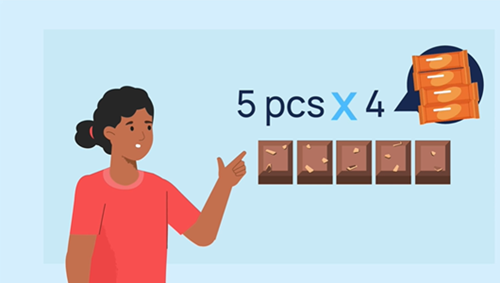
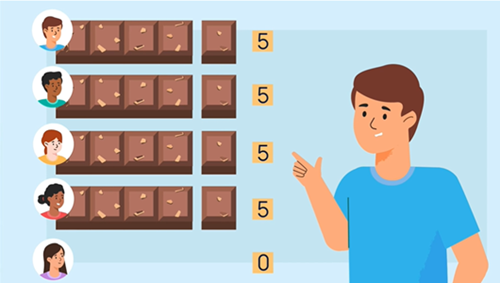
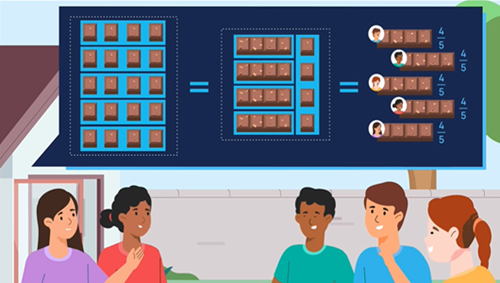
Investigating sharing: more than a whole each
Objective: To understand that when there are fewer people to share between than items to be shared, this results in everybody receiving more than a whole item.
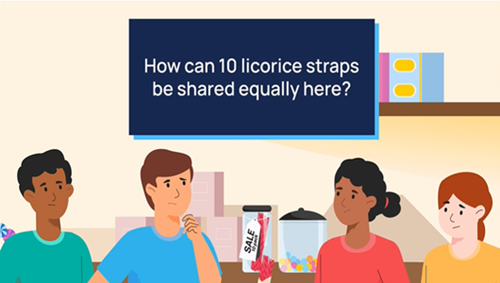
Role of teacher:
Make explicit that this is about sharing fairly or equally when there is more than enough to give each person a whole item. Demonstrate two ways of describing how 10 items could be shared equally between 4 friends. The first example is to divide each whole equally into two pieces, making 20 pieces in total, which can then be shared equally between the four friends. Alternatively, each person is given as many wholes as possible until the remaining pieces have to be made smaller, so that they all receive the same amount. Ask which way students would choose to share, and why.


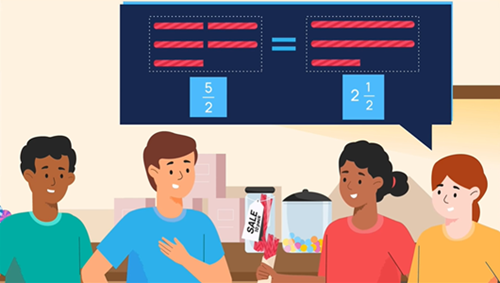
Notice again that the answer is in the question: 10 ÷ 4 =104 = 52 = 212 .
Reflection (Fractions as division)
Ask students to reflect on their investigations related to sharing food.
What makes a method of sharing efficient? Explain your thinking. When might this not be the case? What number would you need to share by to easily be able to convert to a decimal answer ($10 ÷ 4 or 10 m ÷ 4)?
Extension
How would you share 8 bars between 5 friends or share 10 licorice straps between 3 friends?